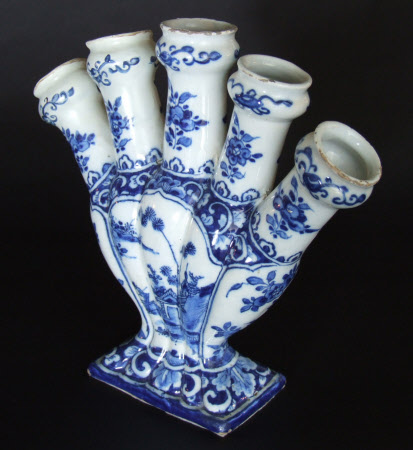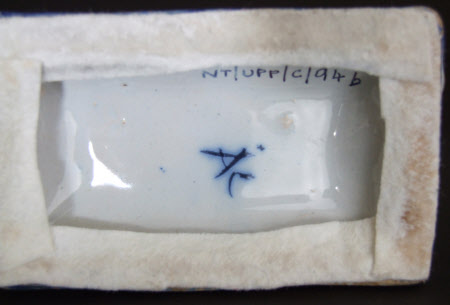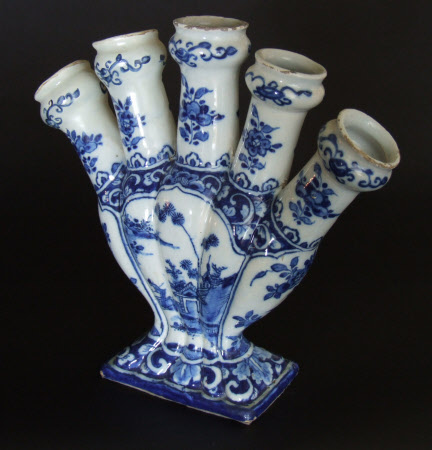Vase
workshop of Adrianus Kocx (fl.1686 - 1701)
Category
Ceramics
Date
1700 - 1701
Materials
Delftware
Measurements
203 x 215 x 63 mm
Place of origin
Delft
Order this imageCollection
Uppark House and Garden, West Sussex
NT 137447.2
Summary
One of a pair of flower vases. Tin-glazed earthenware (Delftware), painted with floral decoration, base marked with the conjoined AK cipher of Adriaenus Koeks, the ‘Greek A’ factory, Delft, the Netherlands, about 1700. (NT/UPP/C/94a is other in pair).
Full description
One of two blue and white fan-shaped flower vases, one painted in cobalt oxide and the other similarly decorated with ‘trekked’ outlines in black from manganese oxide. The ‘trekked’ example is marked with the conjoined AK cipher of Adriaenus Koeks (or Adriaen Kocks), owner of the ‘Greek A’ factory established in the town of Delft, the Netherlands, owned by him from 1687 to 1701 (NT/UPP/C/94). The marked example is c. 1690 and the unmarked example is c. 1700. These are rare shapes, which were copied in English creamware in the 1770s. Significantly, fragments of two similar vases were excavated from Mary’s garden adjacent to her cellar dairy at Het Loo Palace in Apeldoorn, which match the ‘two flat flower bottles’ in the palace inventory of 1713.[1] The excavated pair date to an earlier period c. 1678-86, when Samuel van Eenhorn owned the ‘Greek A’ factory. At Croft Castle, National Trust, is a needlework chair cover, c. 1725, that depicts on the seat a Delft flower vase filled with cut flowers, this image is less well-known than the back of the chair, which is worked with a blue and white flower pyramid. Sometimes incorrectly called ‘tulip vases’ after the Tulipomania of the 1630s, they were designed to display a variety of cut-flowers, not just tulips, in water filled-tiers. In fact, it was double-headed hyacinths, which were the fashionable flower of the 1690s; the heavy headed flowers were well-supported by the long spouts. [1] A.M.L. Erkelens.”Delffs porcelijn” van Koningin Mary II : ceramiek op Het Loo uit de tijd van Willem III en Mary II /Queen Mary's “Delft porcelain” : ceramics at Het Loo from the time of William and Mary, Apeldoorn, 1996, p. 65.
Marks and inscriptions
initials painted on base, possibly AK or AC
Makers and roles
workshop of Adrianus Kocx (fl.1686 - 1701), manufactory director





